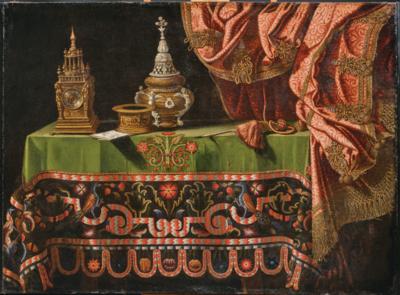Roman School, 17th Century
A wooden table covered with a precious embroidered tablecloth with gilded metalwork, a curtain above,
oil on canvas, 99 x 133.5 cm, framed
Provenance:
Private European collection
The present painting is a significant example of early post-Caravaggesque still life painting in Rome in the first half of the seventeenth century. The meticulous rendering of the gilt table clock, vessel and inkwell, and the fringes of the rug with its heavy folds, accentuated by strong chiaroscuro contrasts, display a careful analysis of reality. The artist of the present painting adds a strong illusionist vein, with an almost tactile imitation of the carpet fabric effected by skillful rendering of the material which seems to emerge from the painted surface, as well as the virtuoso red damask cloth, framing and acting as a backdrop to the elements in the foreground, reminiscent of Caravaggio’s work.
The genre of still life painting flourished in Rome in the wake of Caravaggio, focusing initially on the depiction of flowers, fruit and vegetables and later expanding the range of subjects to include musical instruments, weapons, game and other items. The genre enjoyed such extraordinary success that it led many artists to specialise in this type of painting, including Francesco Noletti. His work exerted influence beyond the city, as can be seen in the work of the Neapolitan painter Giuseppe Recco and Meiffren Conte from France.
Esperto: Mark MacDonnell
 Mark MacDonnell
Mark MacDonnell
+43 1 515 60 403
oldmasters@dorotheum.com
15.12.2023 - 16:56
- Stima:
-
EUR 10.000,- a EUR 15.000,-
- Prezzo di partenza:
-
EUR 10.000,-
Roman School, 17th Century
A wooden table covered with a precious embroidered tablecloth with gilded metalwork, a curtain above,
oil on canvas, 99 x 133.5 cm, framed
Provenance:
Private European collection
The present painting is a significant example of early post-Caravaggesque still life painting in Rome in the first half of the seventeenth century. The meticulous rendering of the gilt table clock, vessel and inkwell, and the fringes of the rug with its heavy folds, accentuated by strong chiaroscuro contrasts, display a careful analysis of reality. The artist of the present painting adds a strong illusionist vein, with an almost tactile imitation of the carpet fabric effected by skillful rendering of the material which seems to emerge from the painted surface, as well as the virtuoso red damask cloth, framing and acting as a backdrop to the elements in the foreground, reminiscent of Caravaggio’s work.
The genre of still life painting flourished in Rome in the wake of Caravaggio, focusing initially on the depiction of flowers, fruit and vegetables and later expanding the range of subjects to include musical instruments, weapons, game and other items. The genre enjoyed such extraordinary success that it led many artists to specialise in this type of painting, including Francesco Noletti. His work exerted influence beyond the city, as can be seen in the work of the Neapolitan painter Giuseppe Recco and Meiffren Conte from France.
Esperto: Mark MacDonnell
 Mark MacDonnell
Mark MacDonnell
+43 1 515 60 403
oldmasters@dorotheum.com
|
Hotline dell'acquirente
lun-ven: 10.00 - 17.00
old.masters@dorotheum.at +43 1 515 60 403 |
| Asta: | Dipinti antichi - Including works from the Rimpau-Langenstein collection |
| Tipo d'asta: | Asta online |
| Data: | 15.12.2023 - 16:56 |
| Luogo dell'asta: | Wien | Palais Dorotheum |
| Esposizione: | 07.12. - 14.12.2023 |

